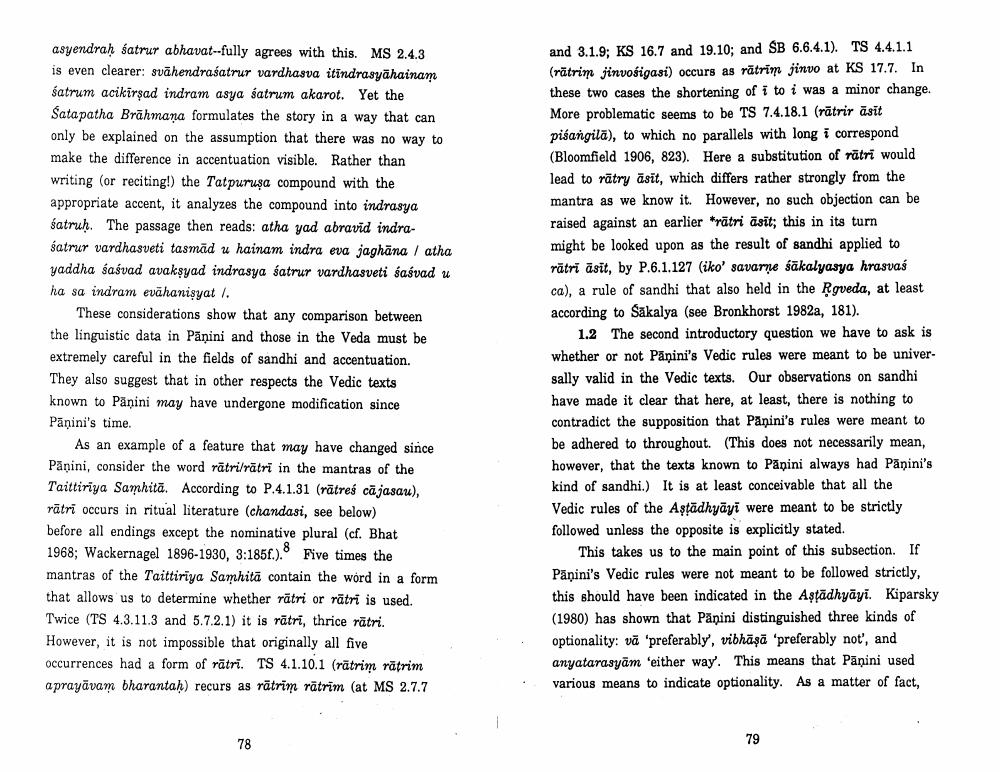Book Title: Paninian And Veda Reconsidered Author(s): Johannes Bronkhorst Publisher: Johannes Bronkhorst View full book textPage 3
________________ asyendraḥ satrur abhavat--fully agrees with this. MS 2.4.3 is even clearer: svahendrasatrur vardhasva itindrasyahainam satrum acikirşad indram asya satrum akarot. Yet the Satapatha Brahmana formulates the story in a way that can only be explained on the assumption that there was no way to make the difference in accentuation visible. Rather than writing (or reciting!) the Tatpurusa compound with the appropriate accent, it analyzes the compound into indrasya satruḥ. The passage then reads: atha yad abravid indrasatrur vardhasveti tasmad u hainam indra eva jaghāna / atha yaddha sasvad avakṣyad indrasya satrur vardhasveti sasvad u ha sa indram evahaniṣyat 1. These considerations show that any comparison between the linguistic data in Panini and those in the Veda must be extremely careful in the fields of sandhi and accentuation. They also suggest that in other respects the Vedic texts known to Panini may have undergone modification since Pāņini's time. 8 As an example of a feature that may have changed since Panini, consider the word ratri/ratri in the mantras of the Taittiriya Samhita. According to P.4.1.31 (ratres cajasau), rātrī occurs in ritual literature (chandasi, see below) before all endings except the nominative plural (cf. Bhat 1968; Wackernagel 1896-1930, 3:185f.). Five times the mantras of the Taittiriya Samhita contain the word in a form that allows us to determine whether rätri or ratri is used. Twice (TS 4.3.11.3 and 5.7.2.1) it is rātri, thrice ratri. However, it is not impossible that originally all five occurrences had a form of ratri. TS 4.1.10.1 (rätrim rātrim aprayāvam bharantaḥ) recurs as rātrīm rātrīm (at MS 2.7.7 78 and 3.1.9; KS 16.7 and 19.10; and SB 6.6.4.1). TS 4.4.1.1 (ratrim jinvośigasi) occurs as rätrim jinvo at KS 17.7. In these two cases the shortening of i to i was a minor change. More problematic seems to be TS 7.4.18.1 (rätrir āsīt pisangila), to which no parallels with long i correspond (Bloomfield 1906, 823). Here a substitution of ratri would lead to rātry äsit, which differs rather strongly from the mantra as we know it. However, no such objection can be raised against an earlier rätri āsīt; this in its turn might be looked upon as the result of sandhi applied to rātrī āsīt, by P.6.1.127 (iko' savarne sakalyasya hrasvas ca), a rule of sandhi that also held in the Ṛgveda, at least according to Sakalya (see Bronkhorst 1982a, 181). 1.2 The second introductory question we have to ask is whether or not Panini's Vedic rules were meant to be universally valid in the Vedic texts. Our observations on sandhi have made it clear that here, at least, there is nothing to contradict the supposition that Panini's rules were meant to be adhered to throughout. (This does not necessarily mean, however, that the texts known to Papini always had Panini's kind of sandhi.) It is at least conceivable that all the Vedic rules of the Astädhyayi were meant to be strictly followed unless the opposite is explicitly stated. This takes us to the main point of this subsection. If Panini's Vedic rules were not meant to be followed strictly, this should have been indicated in the Aṣṭādhyāyi. Kiparsky (1980) has shown that Panini distinguished three kinds of optionality: va 'preferably', vibhāṣā 'preferably not', and anyatarasyam 'either way. This means that Pāņini used various means to indicate optionality. As a matter of fact, 79Page Navigation
1 2 3 4 5 6 7 8 9 10 11 12 13 14 15 16 17 18 19 20 21 22 23 24
